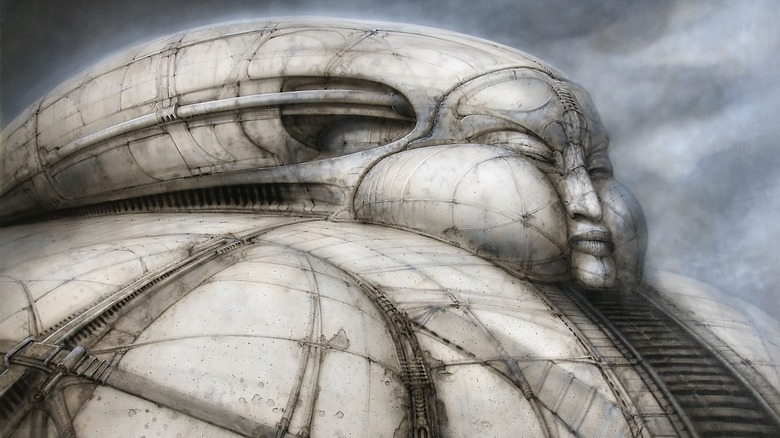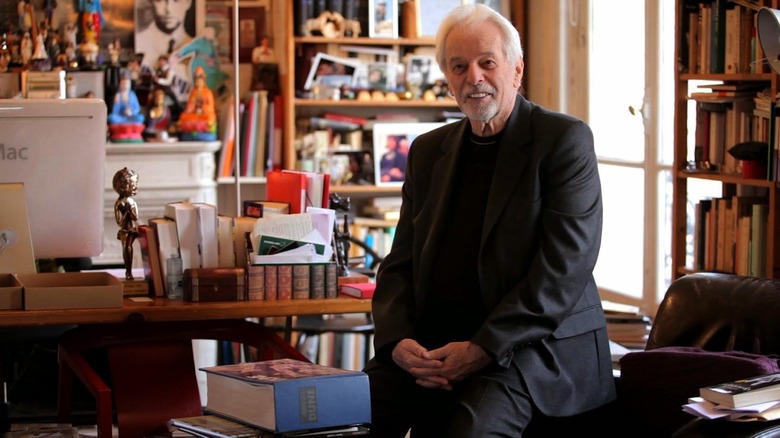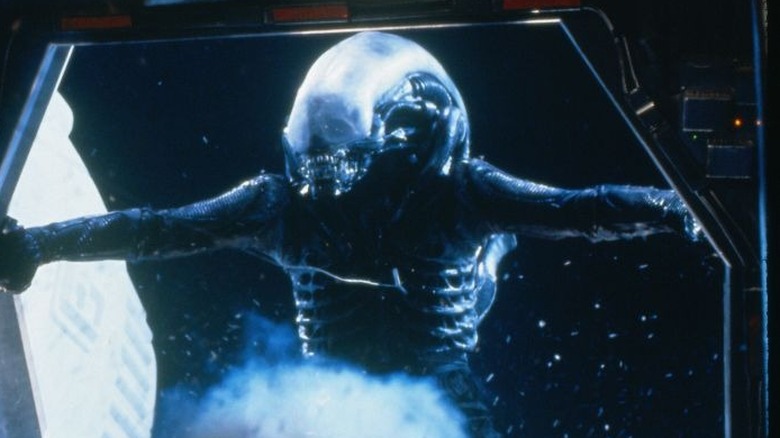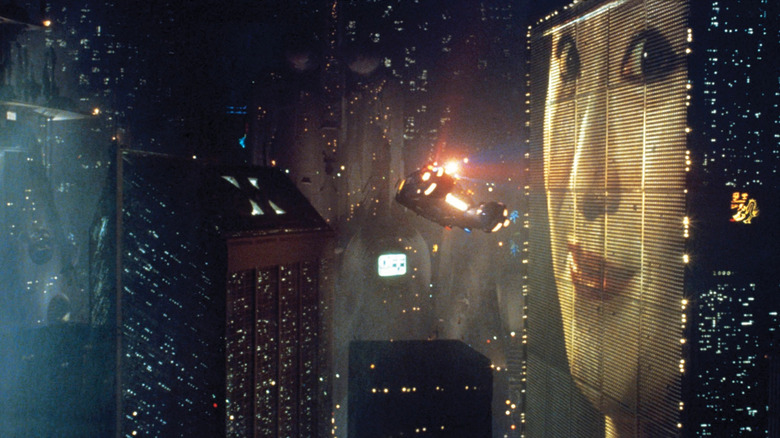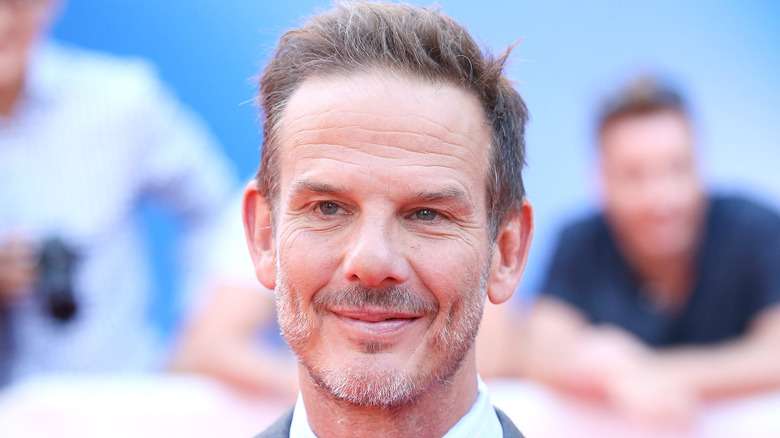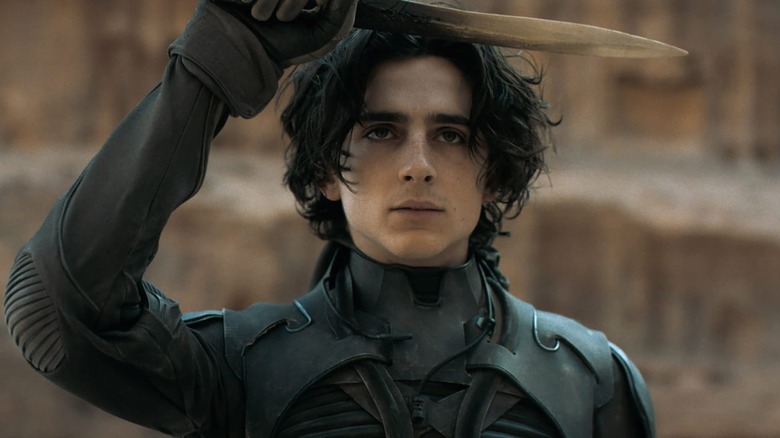Why We Never Saw These Bizarre Dune Movies
In 1971, just six years after Frank Herbert published his groundbreaking science-fiction novel "Dune," Arthur P. Jacobs' Apjac International obtained the rights to the story for a film adaptation. The producer behind "Planet of the Apes" was ready to craft another world set in a distant future, but with the sequel film "Beneath the Planet of the Apes" on its way, "Dune" was delayed.
Jacobs went through a handful of different directors and screenwriters in early development, but he tragically passed away in 1973. David Lynch would eventually bring "Dune" to the big screen in 1984, but there were multiple failed attempts that paved the way for his film and a remake in his wake that led to Denis Villeneuve's recent adaptations. The messy histories of failed "Dune" adaptations could justify their own feature-length documentaries (and in one instance, did) but allow this to be a crash course on the bizarre "Dune" movies that never came to be.
The (extremely) abridged saga of Jodorowsky's Dune
Remember when artistic filmmakers were allowed to be off-the-wall weird and didn't have to modify their work to appease the cruel gods of algorithms? Few filmmakers are as wholly unique as Chilean-French director Alejandro Jodorowsky, whose attempt at adapting "Dune" is so notoriously wild, a 2014 documentary chronicling the failed project was made and is a must-watch for fans of the "Dune" films. Directed by Frank Pavich, "Jodorowsky's Dune" looks at the truly incredible pre-production of a film that never was, with Jodorowsky himself at the center. Had he gotten his wish, "Dune" would have been a 14-hour-long sci-fi epic with his son Brontis ("El Topo") in the lead role of Paul Atreides. Nepotism, sure, but the rest of his dream cast was just as wild.
Jodorowsky wanted Salvador Dalí as Shaddam IV (who would have been paid $100,000 per hour of filming), Amanda Lear as Princess Irulan, Orson Welles as Baron Vladimir Harkonnen, Gloria Swanson as Reverend Mother Gaius Helen Mohiam, David Carradine as Duke Leto Atreides, Geraldine Chaplin as Lady Jessica, Alain Delon as Duncan Idaho, Hervé Villechaize as Gurney Halleck, Udo Kier as Piter De Vries, and Mick Jagger as Feyd-Rautha — with a score by Pink Floyd. Jodorowsky spent $2 million of the intended $9.5 million budget on just pre-production, and after three years of development, it all fell apart. H.R. Giger had been brought in to design the Harkonnen Castle based on Moebius's storyboards (remember this for later) that never came to fruition. Dan O'Bannon, who was to run the special effects department, was hospitalized after the project died and wrote a series of scripts in the aftermath — including the script that would become "Alien."
This connective tissue comes in handy because, in 1976, Dino De Laurentiis obtained the rights to Frank Herbert's novel and found the perfect director for the job.
The start of Ridley Scott's Dune
Shortly after the success of "Alien," director Ridley Scott was hired by De Laurentiis to direct an adaptation of "Dune." Scott was dazzled by the project and briefly discussed his involvement on the fated film during the documentary "Dangerous Days: Making Blade Runner," the film he would actually make instead. "I was attracted to 'Dune' because it was beyond what I'd done on 'Alien' which was kind of hard-core kind of horror film and 'Dune' would be a step very strongly, very, very strongly, in the direction of 'Star Wars,'" he said.
The script came from "Dune" author Frank Herbert, but Scott wasn't sold. He attempted to enlist acclaimed science-fiction writer Harlan Ellison to give a crack at it, but the notoriously grumpy Ellison rejected the offer. In "Harlan Ellison's Watching," his book of 25 years worth of essays and film reviews, Harlan recalled, "On Thursday, September 27, 1979, Ridley Scott came for a breakfast meeting at my home and offered me the assignment to write 'Dune.' He was very nice about it when I told him that I'd sooner spend my declining years vacationing on Devil's Island."
With Ellison out of the picture, Scott tapped "Pat Garrett and Billy the Kid" scribe Rudolph Wurlitzer. For the look of the project, he tapped his "Alien" collaborator H.R. Giger to assist with design elements under the agreement that he'd retain the rights to any of the furniture he designed for the film. The project fell apart before Giger had a chance to construct all of the pieces, but he'd eventually create hauntingly beautiful works incorporating real skulls and bones inspired by House Harkonnen. They can still be viewed today at the Giger Museum in Gruyères, Switzerland.
Why Ridley Scott's Dune fell apart
Though Scott seemed to have finally assembled a proper creative team, Herbert was unhappy with Wurlitzer's script — in particular, an added romantic subplot between Paul Atreides and his mother, Lady Jessica. Wurlitzer defended his decision in Prevue issue #54 (as transcribed cited in the book "A Masterpiece in Disarray") by saying, "I felt there was always a latent, but very strong, Oedipal attraction between them, and I took it one note further. It went right in the middle of the film, as a supreme defiance of certain boundaries, perhaps making Paul even more heroic for having broken a forbidden code." It took another eight months before the script got to a place where everyone seemed happy.
Alas, De Laurentiis and Universal Studios weren't thrilled with the anticipated $50 million budget. That might not seem like a huge number for a blockbuster film, but keep in mind that in 2024 dollars, that's a budget of over $226.5 million — over $60 million more than the cost of Denis Villeneuve's "Dune." The delays in getting the script up to snuff and the budgetary issues all but guaranteed Scott's "Dune" wouldn't come to fruition, and he officially left the project in 1980 following the passing of his older brother, Frank. Ridley Scott pivoted to working on "Blade Runner" and the rest, as they say, is history.
It was Scott's departure that would pave the way for David Lynch's eventual "Dune" film, which proved to be just as difficult to produce and distribute as the numerous "Dune" movies that never made it to screen.
The failed Dune for a new millennium
As is the case with just about every gigantic IP, there were talks in the late 2000s about a possible new "Dune" movie following John Harrison's 2000 made-for-TV miniseries, "Frank Herbert's Dune" and its 2003 sequel, "Frank Herbert's Children of Dune." Herbert's grandson Byron Merritt posted about it on the Dune Novels forum in 2007 (as captured by DuneNewsNet), claiming that a deal to make a new film had been in the works with a studio for "years" and that he'd hoped whoever the interested director was could do the book justice. The rumor mill began swirling, but a few months later, Ain't It Cool News reported that Paramount Pictures was the studio in question, with "Friday Night Lights" and "The Kingdom" director Peter Berg in talks to direct.
Alas, this timing would coincide with the 2008 WGA strike, which meant there was no actual script attached to the new project. Paramount wouldn't find a writer until June of 2008, nabbing future "RoboCop" (2014) and "Patriot's Day" screenwriter Josh Zetumer for the project. The former was Zetumer's big break in the industry, so let this be a reminder that there's no such thing as an "overnight sensation," considering he was working on "Dune" a full six years before finally getting a feature screenplay produced.
A then-23-year-old Robert Pattinson was being courted to play Paul Atreides, fresh off his success in "Twilight." However, Berg dropped out in October of 2009 and went on to make "Battleship." Paramount went on a search for a new director, looking at both Neill Blomkamp ("District 9") and Neil Marshall ("The Descent") but eventually decided on "Taken" director, Pierre Morel. A new director meant a new vision, which meant a new screenwriter to make the changes.
Why the 2000s Dune fell apart
Chase Palmer was brought in, who had only written short films and television at the time. His big feature break would come in 2017 with "It: Chapter One," so once again, a hardworking screenwriter attempted "Dune" before having a feature script successfully produced. Palmer's script was more of an action-adventure story than Herbert's original novel, and Morel had commissioned art director Kevin Jenkins to help come up with the look of the film. If the name is unfamiliar, Jenkins would later work on films like "Guardians of the Galaxy," "Jurassic World: Dominion," and the "Star Wars" sequel trilogy, among many others.
However, by the end of 2010, Pierre Morel had left the project as a director but stayed on as an executive producer. This meant that Paramount was once again on the hunt for a new director, but there was a massive problem — if they didn't start production by the spring of 2011, the rights to the novel would expire. And, well, that's exactly what happened. The rights holders had no interest in extending their deal with Paramount and so the rights lapsed and Paramount was out. No other studio wanted to pick up the pieces that Paramount left behind, and "Dune" would remain out of production conversations until Legendary Entertainment gained the rights in 2016, with Villeneuve signing on in 2017.
They say everything happens for a reason, and based on the wild success of the new "Dune" films, it seems like the universe aligned exactly as intended.
